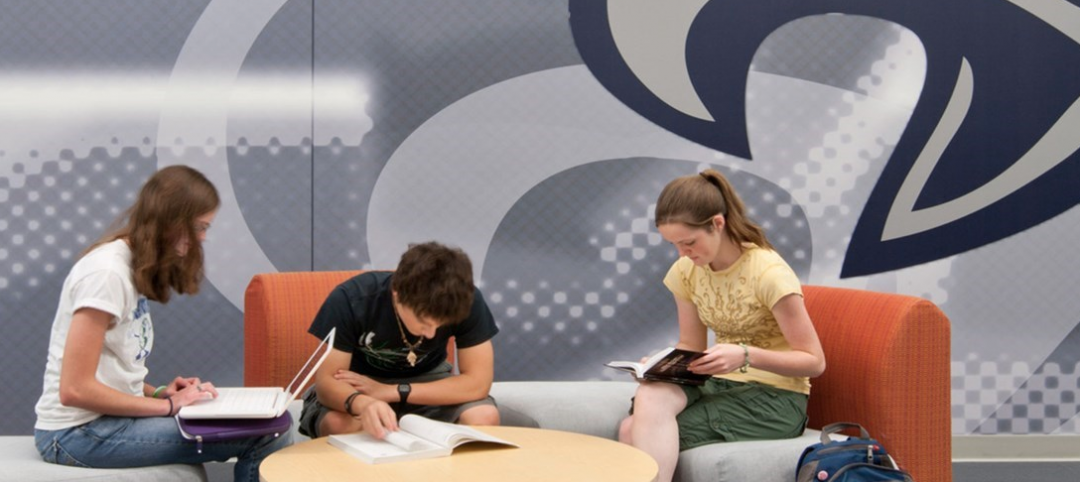Dunbar High School in Washington, D.C., has been certified LEED Platinum, the highest distinction, by the U.S. Green Building Council. Designed Perkins Eastman in association with Moody•Nolan, the 280,000-sf school achieved 91 points, out of 100 base points possible for LEED, making it the highest-scoring school in the world certified under USGBC’s LEED for Schools-New Construction system. The new school building welcomed its first students in 2013.
Located blocks from the U.S. Capitol, the high school provides a high-performance 21st-century learning environment designed to catalyze the renewal of one of our most historic schools. The nation’s first public high school for African Americans, Dunbar was originally founded in 1870 and relocated to the current site in 1917. Demolished in the 1970s, the 1917 building was a particular point of civic pride in the community, representing the values and dreams of the students, their families, and the larger community, and their aspirations for notable achievement.
The school campus raises the bar for sustainable, high-performance school design in the District and for the students’ environmental stewardship. Its more prominent sustainable design attributes include:
- 482 kW photovoltaic array, provided through Washington, D.C.’s first power purchase agreement, that generates enough energy on a sunny summer day to power all classroom lights for eight hours
- Washington, D.C.’s largest ground-source heat pump system below Dunbar’s athletic field, with wells extending 460 feet deep
- The reopening of O Street as a sustainable model that features 6,152 sf of rain gardens able to handle a 1.2-inch storm event
- Pervasive natural light resulting from proper orientation and shading of the building
- Two 20,000-gallon cisterns and low-flow fixtures help save over 1,400,000 gallons of potable water/year
- Enhanced acoustics that help create a high-performance learning environment.
“Dunbar’s LEED Platinum achievement is a testament to the power of vision and dedication to create a truly sustainable high-performance learning environment,” says Sean O’Donnell AIA, LEED AP, Principal-in-Charge of the project and the leader of Perkins Eastman’s K-12 practice area. “In the same year that the school has been certified Platinum, it has also posted the highest standardized test score gains in the entire city—this after only one year in the building. I believe that innovative design has created a synergy with the school’s educational transformation initiatives that is resulting in more successful educational outcomes for the students.”
The school was designed in close collaboration with the Department of General Services, the District of Columbia Public Schools, the school and its alumni, the community, and the design and construction team, which was a joint venture between Perkins Eastman, Setty Associates International, and SK&A Structural Engineers in association with Moody•Nolan. The team also includes Smoot/Gilbane Construction.





Related Stories
| May 30, 2018
Accelerate Live! talk: From micro schools to tiny houses: What’s driving the downsizing economy?
In this 15-minute talk at BD+C’s Accelerate Live! conference (May 10, 2018, Chicago), micro-buildings design expert Aeron Hodges, AIA, explores the key drivers of the micro-buildings movement, and how the trend is spreading into a wide variety of building typologies.
| May 24, 2018
Accelerate Live! talk: Security and the built environment: Insights from an embassy designer
In this 15-minute talk at BD+C’s Accelerate Live! conference (May 10, 2018, Chicago), embassy designer Tom Jacobs explores ways that provide the needed protection while keeping intact the representational and inspirational qualities of a design.
K-12 Schools | Jan 25, 2018
Cost estimating for K-12 school projects: An invaluable tool for budget management
Clients want to be able to track costs at every stage of a project, and cost estimates (current and life cycle) are valuable planning and design tools, writes LS3P's Ginny Magrath, AIA.
K-12 Schools | Jan 24, 2018
Hawaii’s first net-zero public school
G70 is the architect, planner, and civil engineer of record for the project.
K-12 Schools | Jan 22, 2018
Innovative learning environments and our ‘Heschong Mahone moment’
An education market think tank proposes a radical research concept for evaluating learning environments.
K-12 Schools | Dec 6, 2017
Designing K-12 schools from the inside out
A step-by-step process finds better answers, saves money, and produces measurable results.
K-12 Schools | Nov 16, 2017
Future-proofing higher education: Understanding generation Z
There are three driving issues behind this next generation: demographic change, behavioral change, and the power to choose.
Engineers | Nov 2, 2017
CannonDesign expands its presence in Colorado with BWG acquisition
Future mergers could be in the offing.
K-12 Schools | Oct 31, 2017
Exploring empathy in architecture: Put yourself in your student’s shoes
People are enigmatic and inherently complex, which can make it difficult to design for a larger population.
K-12 Schools | Oct 28, 2017
A new elementary school in Cambridge, Mass., aims at being a pilot for that city’s NZE commitment
The building’s programming will provide more access to the community at large.















